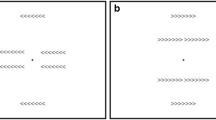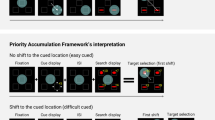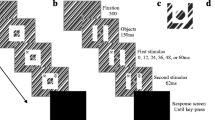Abstract
Experiments by Umiltà and Liotti (1987) and Lamberts, Tavernier, & d'Ydewalle (1992) examined the Simon effect (an influence of irrelevant stimulus location on reaction time) as a function of multiple frames of reference. The Simon effect was absent for all reference frames in the former experiment, leading Stoffer (1991) to propose that a spatial code is formed only if the last step in directing attention to the imperative stimulus is a lateral shift. However, the Simon effect was evident for all frames in the latter experiment. Hommel (1994) proposed that the multiple spatial codes implied by Lamberts et al.'s findings were also activated in Umiltà and Liotti's experiment but had decayed by the time the relevant stimulus information had been identified. Experiments 1, 2, and 3 examined these accounts of attention shifting, multiple codes, and temporal overlap for variations of the Simon task in which the stimulus could occur in one of either eight or four possible stimulus locations. Three stimulus sets that differed in ease of discriminability were used in each experiment. Experiments 1 and 2 were replications and extensions of those of Lamberts et al. and Umiltá and Liotti, respectively. In both experiments, two boxes, with a stimulus inside of one, appeared simultaneously, and the subject was to respond to the identity of the stimulus. Experiment 3 used a procedure in which the four stimulus locations were demarcated by three vertical lines. Two of the three experiments showed Simon effects with respect to multiple frames of reference, and the magnitude of these effects was a decreasing function of the difficulty of stimulus discriminability. Spatial compatibility proper was examined in Experiment 4 using the same layout as Experiment 3. In this case, only the relevant frame of reference was coded. On the whole, the results indicate that multiple codes are formed, but not automatically, and that those codes decay when irrelevant.
Similar content being viewed by others
References
De Jong, R., Liang, C.-C., & Lauber, E. (1994). Conditional and unconditional automaticity: A dual-process model of effects of spatial stimulus-response correspondence. Journal of Experimental Psychology: Human Perception and Performance, 20, 731–750.
Fitts, P. M., & Deininger, R. L. (1954). S-R compatibility: Correspondence among paired elements within stimulus and response codes. Journal of Experimental Psychology, 48, 483–492.
Fitts, P. M., & Seeger, C. M. (1953). S-R compatibility: Spatial characteristics of stimulus and response codes. Journal of Experimental Psychology, 46, 199–210.
Hommel, B. (1994). Effects of irrelevant spatial S-R compatibility depend on stimulus complexity. Psychological Research, 56, 179–184.
Hommel, B. (in press). Toward an action concept model. In B. Hommel & W. Prinz (Eds.), Theoretical issues in stimulus-response compatibility. Amsterdam: North-Holland.
Lamberts, K, Tavernier, G., & d'Ydewalle, G. (1992). Effects of multiple reference points in spatial stimulus-response compatibility. Acta Psychologica, 79, 115–130.
Lu, C. H., & Proctor, R. W. (1995). The influence of irrelevant location information on performance: A review of the Simon and spatial Stroop effects. Psychonomic Bulletin & Review, 2, 174–207.
Nicoletti, R., Anzola, G. P., Luppino, G., Rizzolatti, G., & Umiltà, C. (1982). Spatial compatibility effects on the same side of the body midline. Journal of Experimental Psychology: Human Perception and Performance, 8, 664–673.
Proctor, R. W., & Dutta, A. (1993). Do the same stimulus-response relations influence choice reactions initially and after practice? Journal of Experimental Psychology: Learning, Memory, and Cognition, 19, 922–930.
Robinson, A. (Ed.). (1979). In the cockpit. New York: Ziff-Davis.
Simon, J. R. (1990). The effects of an irrelevant directional cue on human information processing. In R. W. Proctor & T. G. Reeve (Eds.), Stimulus-response compatibility: An integrated perspective (pp. 31–86). Amsterdam: North-Holland.
Simon, J. R., & Rudell, A. P. (1967). Auditory S-R compatibility: The effect of an irrelevant cue on information processing. Journal of Applied Psychology, 51, 300–304.
Stoffer, T. H. (1991). Attentional focussing and spatial-response compatibility. Psychological Research, 53, 127–135.
Umiltà, C. & Liotti, M. (1987). Egocentric and relative spatial codes in s-r compatibility. Psychological Research, 49, 81–90.
Umiltà, C., & Nicoletti, R. (1985). Attention and coding effects in S-R compatibility due to irrelevant spatial cues. In M. I. Posner & O. S. M. Marin (Eds.), Attention and performance XI (pp. 457–471). Hillsdale, NJ: Erlbaum.
Wallace, R. J. (1971). S-R compatibility and the idea of a response code. Journal of Experimental Psychology, 88, 354–360.
Wallace, R. J. (1972). Spatial S-R compatibility effects involving kinesthetic cues. Journal of Experimental Psychology, 93, 163–168.
Zorzi, M., & Umiltà, C. (1995). A computational model of the Simon effect. Psychological Research, 58, 193–205.
Author information
Authors and Affiliations
Corresponding author
Rights and permissions
About this article
Cite this article
Roswarski, T.E., Proctor, R.W. Multiple spatial codes and temporal overlap in choice-reaction tasks. Psychol. Res 59, 196–211 (1996). https://doi.org/10.1007/BF00425834
Received:
Accepted:
Issue Date:
DOI: https://doi.org/10.1007/BF00425834




